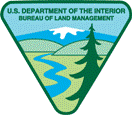United States Department of the Interior

United States Bureau of Land Management: Staff Publications
Date of this Version
8-6-1992
Citation
Published in Hydraulic Engineering: Saving a Threatened Resource—In Search of Solutions: Proceedings of the Hydraulic Engineering sessions at Water Forum ’92. Baltimore, Maryland, August 2–6, 1992. Published by American Society of Civil Engineers.
Abstract
The Bureau of Reclamation owns and operates over 300 dams throughout the 17 western states. For most of these structures, tailwater measurements and steady-state water surface profile computations have been made using the PSEUDO program. Accuracy in water surface profile computations especially downstream from powerplants has been important. Small changes in differential head can mean large changes in power production and associated revenues generated. Peaking operations and flow fluctuations downstream from some dams has made flow conditions unsteady. The DWOPER program has been used to evaluate tailwater conditions under fluctuating flows at a number of sites. The STARS model was developed in Reclamation to incorporate the movement of sediment into water routing. Water surface profile computations are an integral part of the water and sediment routing process.
This paper presents case histories in the use of the PSEUDO, STARS, and DWOPER models in Reclamation to evaluate tailwater conditions. The developmental theories, varying uses, and intended purposes of the three models are discussed and comparisons of computed water surface profiles to measured data are presented.

